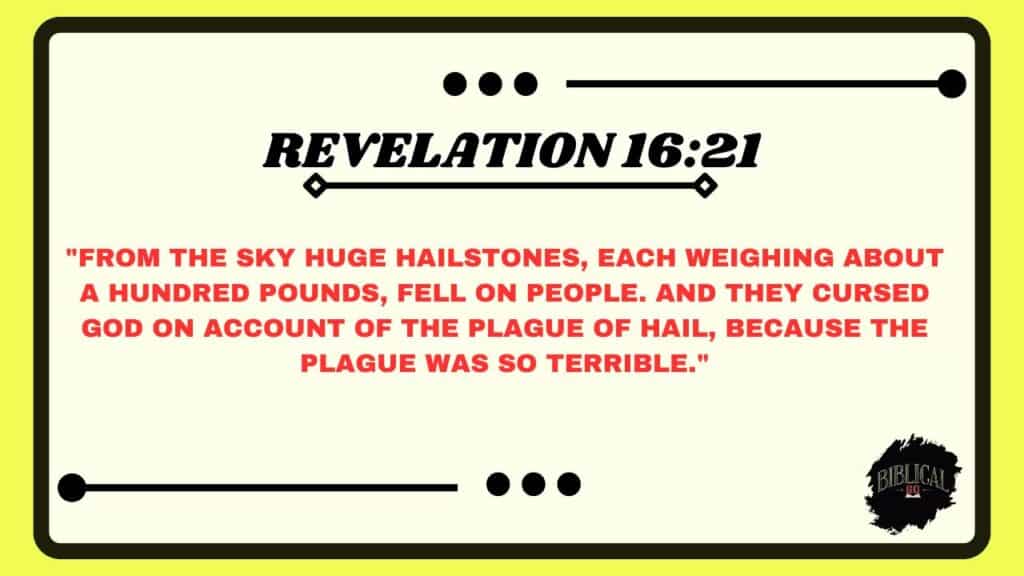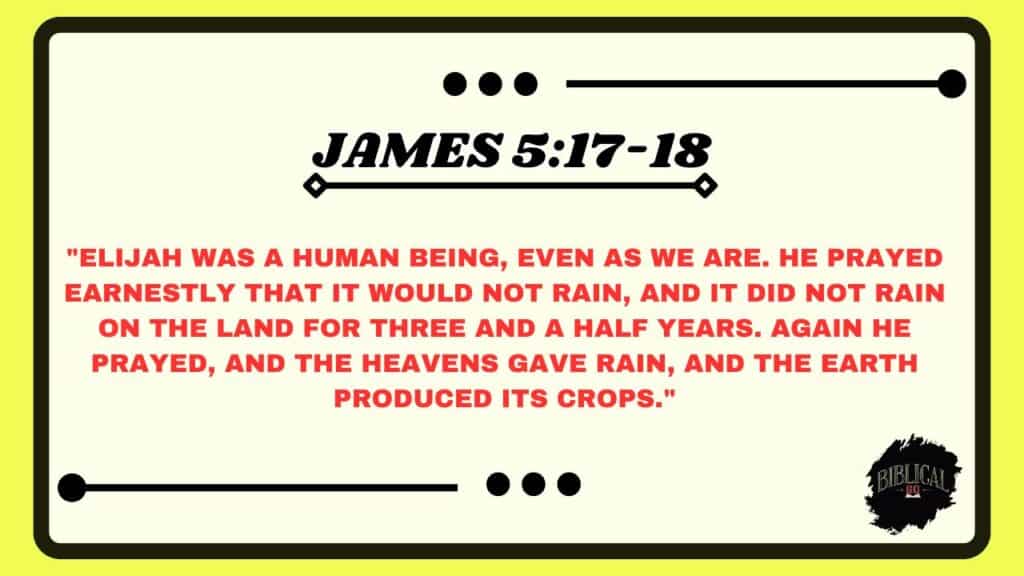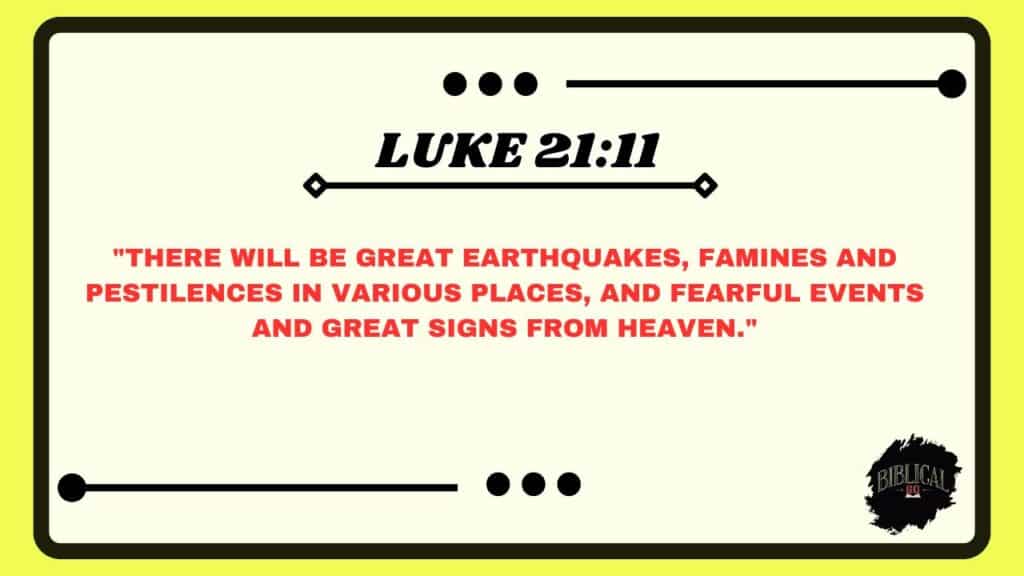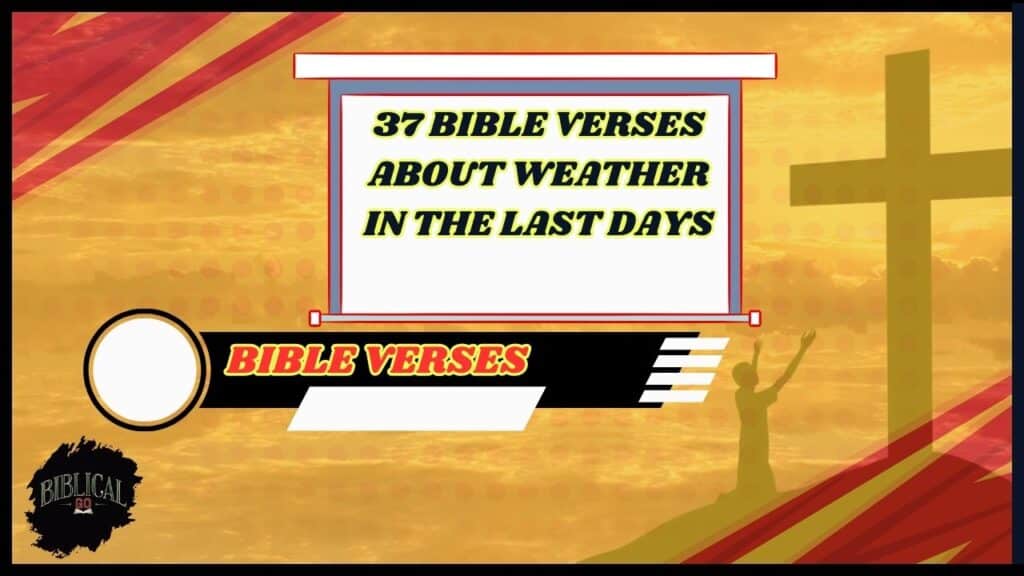Bible Verses About Weather in the Last Days: Scripture, weather often serves as both a physical reality and a powerful metaphor for God’s activity in the world. When the Bible speaks of the last days or end times, weather phenomena frequently appear as signs and symbols of divine intervention.
These weather-related prophecies aren’t merely ancient curiosities they offer profound insight for believers today seeking to understand the signs of the times. As our world experiences increasingly extreme weather patterns, many Christians wonder if these events connect to biblical prophecies about the end times.
The Bible provides remarkable clarity about how weather will feature prominently as history moves toward its divine conclusion. These passages remind us that God remains sovereign over all creation, including the atmospheric conditions that impact our daily lives.
Also Read: 37 Bible Verses About Dreams Coming True
Signs in the Sky: Celestial Weather Phenomena
1. Matthew 24:29
“Immediately after the distress of those days the sun will be darkened, and the moon will not give its light; the stars will fall from the sky, and the heavenly bodies will be shaken.”
Jesus describes dramatic celestial events that will occur during the end times. These astronomical disturbances signal a fundamental disruption in the created order, demonstrating God’s power over the entire cosmos. When we observe unusual celestial phenomena today, they can remind us of Christ’s promise to return and the temporary nature of our current reality.
2. Revelation 6:12-13
“I watched as he opened the sixth seal. There was a great earthquake. The sun turned black like sackcloth made of goat hair, the whole moon turned blood red, and the stars in the sky fell to earth, as figs drop from a fig tree when shaken by a strong wind.”
John’s apocalyptic vision includes dramatic changes to sun, moon, and stars, accompanied by a great earthquake. These cosmic disturbances symbolize the collapse of existing world systems and authorities as God’s judgment unfolds. This passage reminds us that even the most stable elements of creation remain under God’s authority and can be altered at His command.
3. Joel 2:30-31
“I will show wonders in the heavens and on the earth, blood and fire and billows of smoke. The sun will be turned to darkness and the moon to blood before the coming of the great and dreadful day of the Lord.”

Joel prophesies about remarkable atmospheric and celestial signs that will precede the Day of the Lord. These phenomena serve as warnings and calls to repentance before final judgment comes. As believers, we should view unusual celestial events not with fear but as reminders of God’s unfolding plan and our need to remain spiritually vigilant.
4. Acts 2:19-20
“I will show wonders in the heavens above and signs on the earth below, blood and fire and billows of smoke. The sun will be turned to darkness and the moon to blood before the coming of the great and glorious day of the Lord.”
Peter quotes Joel’s prophecy, applying it to both the outpouring of the Holy Spirit at Pentecost and the future day of the Lord. These cosmic signs bracket the church age, marking both its beginning and eventual conclusion. This reminds us that we live in a significant historical period between Christ’s first and second comings, with the natural world itself bearing witness to God’s redemptive plan.
5. Isaiah 13:10
“The stars of heaven and their constellations will not show their light. The rising sun will be darkened and the moon will not give its light.”
Isaiah describes cosmic darkness as part of God’s judgment. The disruption of normal celestial patterns signifies the overturning of the established order as God intervenes in human history. When we consider the reliability of celestial bodies, we gain perspective on how dramatic these prophesied changes will be, demonstrating the seriousness of God’s final judgment.
Storms and Floods: Water-Based Judgments
6. Luke 21:25
“There will be signs in the sun, moon and stars. On the earth, nations will be in anguish and perplexity at the roaring and tossing of the sea.”
Jesus predicts that unusual ocean activity will cause widespread fear and confusion in the last days. These maritime disturbances will be so severe that they contribute to international anxiety and disorder. Today’s rising sea levels and increasingly powerful ocean storms might serve as precursors to these more dramatic events, reminding us of our vulnerability before nature’s power.
7. Genesis 7:11-12
“In the six hundredth year of Noah’s life, on the seventeenth day of the second month on that day all the springs of the great deep burst forth, and the floodgates of the heavens were opened. And rain fell on the earth forty days and forty nights.”
While describing past judgment, this account establishes a pattern for how God uses water as an instrument of judgment. Jesus specifically connected Noah’s flood to end-time events (Matthew 24:37-39). When we face flooding or extreme rainfall today, we can reflect on both God’s judgment against sin and His faithfulness in preserving His people through catastrophic events.
8. 2 Peter 3:5-7
“But they deliberately forget that long ago by God’s word the heavens came into being and the earth was formed out of water and by water. By these waters also the world of that time was deluged and destroyed. By the same word the present heavens and earth are reserved for fire, being kept for the day of judgment and destruction of the ungodly.”
Peter connects Noah’s flood with the coming judgment by fire, emphasizing water’s role in both creation and judgment. This passage reveals that natural elements, including water, serve God’s purposes throughout salvation history. We’re reminded that God can use the same elements that sustain life to execute judgment, highlighting His complete sovereignty over creation.
9. Revelation 16:3
“The second angel poured out his bowl on the sea, and it turned into blood like that of a dead person, and every living thing in the sea died.”
John describes a devastating judgment affecting earth’s oceans, causing mass marine death. This ecological catastrophe demonstrates how God’s judgment will impact not just humanity but entire ecosystems. As we witness oceanic dead zones and marine life die-offs today, we glimpse possible forerunners to these more comprehensive judgments, calling us to environmental stewardship and spiritual preparation.
10. Ezekiel 38:22
“I will execute judgment on him with plague and bloodshed; I will pour down torrents of rain, hailstones and burning sulfur on him and on his troops and on the many nations with him.”

Ezekiel prophesies about a devastating storm that will destroy armies opposing God’s people. This supernatural storm combines multiple elements rain, hail, and burning sulfur demonstrating God’s ability to use weather as a weapon against His enemies. This passage reassures believers that God will ultimately defend His people against overwhelming odds, using creation itself as His instrument.
Also Read: 36 Bible Verses About Manifestation
Fire and Heat: Judgments of Burning
11. 2 Peter 3:10
“But the day of the Lord will come like a thief. The heavens will disappear with a roar; the elements will be destroyed by fire, and the earth and everything done in it will be laid bare.”
Peter describes the ultimate fate of the current creation consumption by fire as part of divine judgment. This cosmic conflagration will reveal everything previously hidden and purify creation. As we witness increasing wildfires and heat waves globally, these events can serve as sobering reminders of creation’s temporary nature and the coming judgment by fire.
12. Revelation 8:7
“The first angel sounded his trumpet, and there came hail and fire mixed with blood, and it was hurled down on the earth. A third of the earth was burned up, a third of the trees were burned up, and all the green grass was burned up.”
John describes a devastating judgment involving fire that destroys significant portions of earth’s vegetation. This ecological disaster represents divine judgment manifested through natural elements. When we witness massive wildfires today, they can remind us of our responsibility to care for creation while also recognizing God’s ultimate authority over the natural world.
13. Revelation 16:8-9
“The fourth angel poured out his bowl on the sun, and the sun was allowed to scorch people with fire. They were seared by the intense heat and they cursed the name of God, who had control over these plagues, but they refused to repent and glorify him.”
John prophesies about extreme solar heat that will cause widespread suffering during the tribulation period. This intensification of the sun’s normal function demonstrates God’s control over cosmic energy sources. In an era of rising global temperatures and heat waves, this passage reminds us that climate conditions ultimately remain under divine sovereignty, even as they call us to responsible stewardship.
14. Malachi 4:1
“Surely the day is coming; it will burn like a furnace. All the arrogant and every evildoer will be stubble, and the day that is coming will set them on fire,” says the Lord Almighty. “Not a root or a branch will be left to them.”
Malachi uses the metaphor of fire to describe God’s judgment against wickedness. This consuming fire represents the thoroughness and finality of divine judgment against evil. When we observe the destructive power of fire today, it can remind us of sin’s consequences and motivate us toward righteous living in preparation for Christ’s return.
15. Isaiah 30:26
“The moon will shine like the sun, and the sunlight will be seven times brighter, like the light of seven full days, when the Lord binds up the bruises of his people and heals the wounds he inflicted.”
Isaiah describes intensified celestial light that accompanies God’s restoration of His people. This dramatically increased brightness signifies purification, healing, and restoration. While this passage suggests judgment for some, it promises healing for God’s faithful reminding us that the same events that bring judgment to some will bring deliverance to others.
Earthquakes and Earth Changes
16. Matthew 24:7
“Nation will rise against nation, and kingdom against kingdom. There will be famines and earthquakes in various places.”
Jesus includes earthquakes among the signs that will characterize the end times. These seismic events are listed alongside human conflicts and food shortages as indicators of the age’s conclusion. As we witness increasing earthquake activity today, these events can remind us of Christ’s prophetic words and prompt us to evaluate our spiritual readiness.
17. Revelation 6:12
“I watched as he opened the sixth seal. There was a great earthquake. The sun turned black like sackcloth made of goat hair, the whole moon turned blood red.”
John describes a massive earthquake accompanying other cosmic signs during the tribulation period. This seismic event is so powerful that it coincides with dramatic celestial changes, suggesting a global catastrophe. When we feel even minor tremors today, they can remind us of earth’s instability and our need to build our lives on the unshakable foundation of God’s kingdom.
18. Revelation 16:18-20
“Then there came flashes of lightning, rumblings, peals of thunder and a severe earthquake. No earthquake like it has ever occurred since mankind has been on earth, so tremendous was the quake. The great city split into three parts, and the cities of the nations collapsed… Every island fled away and the mountains could not be found.”
John prophesies about the most powerful earthquake in human history, causing unprecedented topographical changes. This cataclysmic event will reshape earth’s surface, demonstrating God’s power over even the most stable features of our planet. Today’s earthquakes, while devastating, are mere whispers compared to this future event a sobering reminder of God’s ultimate authority over creation.
19. Ezekiel 38:19-20
“In my zeal and fiery wrath I declare that at that time there shall be a great earthquake in the land of Israel. The fish in the sea, the birds in the sky, the beasts of the field, every creature that moves along the ground, and all the people on the face of the earth will tremble at my presence. The mountains will be overturned, the cliffs will crumble and every wall will fall to the ground.”
Ezekiel describes a massive earthquake affecting Israel that will impact all creation. This comprehensive trembling extends beyond geology to include all living creatures, signifying creation’s response to God’s presence. When we study fault lines and tectonic activity in Israel today, we’re reminded of the prophetic significance of this region in God’s unfolding plan.
20. Haggai 2:6-7
“This is what the Lord Almighty says: ‘In a little while I will once more shake the heavens and the earth, the sea and the dry land. I will shake all nations, and what is desired by all nations will come, and I will fill this house with glory,’ says the Lord Almighty.”
Haggai prophesies about God “shaking” both the natural world and human societies. This divine disruption serves a redemptive purpose to reveal what is truly valuable and establish God’s glory. As we witness societal upheaval alongside natural disasters today, we can remember that God’s shaking is purposeful, designed to distinguish between what is temporary and what is eternal.
Also Read: 36 Bible Verses About Cheating Husbands (Explained)
Extreme Weather Patterns
21. Revelation 11:6
“They have power to shut up the heavens so that it will not rain during the time they are prophesying; and they have power to turn the waters into blood and to strike the earth with every kind of plague as often as they want.”
This verse describes how God’s witnesses will have authority over weather, causing drought at will. This supernatural control demonstrates divine authorization and power working through human agents. While today’s drought conditions have natural explanations, they remind us that rainfall ultimately remains under God’s sovereignty, and can be withheld as part of His purposes.
22. Revelation 16:21
“From the sky huge hailstones, each weighing about a hundred pounds, fell on people. And they cursed God on account of the plague of hail, because the plague was so terrible.”

John foresees supernaturally large hailstones striking the earth during the tribulation. These massive ice projectiles far exceed anything in recorded meteorological history, demonstrating supernatural judgment. Today’s hailstorms, while destructive, pale in comparison to this future event reminding us of the escalating nature of end-time judgments.
23. Job 38:22-23
“Have you entered the storehouses of the snow or seen the storehouses of the hail, which I reserve for times of trouble, for days of war and battle?”
God speaks of snow and hail as weapons reserved for judgment. This poetic language reveals that God can deploy precipitation as instruments of His will during conflicts. When we experience winter storms today, we might reflect on God’s complete control over all weather elements and His ability to use them for both blessing and judgment.
24. Exodus 9:23-24
“When Moses stretched out his staff toward the sky, the Lord sent thunder and hail, and lightning flashed down to the ground. So the Lord rained hail on the land of Egypt; hail fell and lightning flashed back and forth. It was the worst storm in all the land of Egypt since it had become a nation.”
While describing a historical judgment, this passage establishes hail as an instrument of divine judgment. The Egyptian plague demonstrates God’s ability to target specific regions with supernatural weather phenomena. When severe storms strike today, they can remind us of God’s power to intervene in human affairs through weather events that exceed normal patterns.
25. Zechariah 14:17
“If any of the peoples of the earth do not go up to Jerusalem to worship the King, the Lord Almighty, they will have no rain.”
Zechariah connects rainfall with obedience and worship in the messianic kingdom. This conditional blessing demonstrates how weather will function as both incentive and consequence in God’s future reign. As we depend on regular rainfall for agriculture today, this passage reminds us that all natural provision ultimately comes from God and should inspire our worship and obedience.
Also Read: 37 Important Bible Verses About Eagles (Explained)
Drought and Famine Conditions
26. Revelation 6:5-6
“When the Lamb opened the third seal, I heard the third living creature say, ‘Come!’ I looked, and there before me was a black horse! Its rider was holding a pair of scales in his hand. Then I heard what sounded like a voice among the four living creatures, saying, ‘Two pounds of wheat for a day’s wages, and six pounds of barley for a day’s wages, and do not damage the oil and the wine!'”
John describes severe food shortages and economic inflation during the tribulation period. These conditions suggest drought and agricultural failure leading to dramatically increased food prices. As we witness food insecurity and inflation today, these challenges remind us of our dependence on regular weather patterns for sustenance and economic stability.
27. Jeremiah 14:1-6
“This is the word of the Lord that came to Jeremiah concerning the drought: ‘Judah mourns, her cities languish; they wail for the land, and a cry goes up from Jerusalem. The nobles send their servants for water; they go to the cisterns but find no water. They return with their jars unfilled; dismayed and despairing, they cover their heads. The ground is cracked because there is no rain in the land; the farmers are dismayed and cover their heads. Even the doe in the field deserts her newborn fawn because there is no grass. Wild donkeys stand on the barren heights and pant like jackals; their eyes fail for lack of food.'”
Jeremiah vividly describes the comprehensive effects of drought on society and wildlife. This passage shows how water scarcity impacts all levels of society and disrupts normal ecological relationships. When regions experience drought today, Jeremiah’s description reminds us of water’s fundamental importance and how its absence reverberates through every aspect of life.
28. Amos 4:7
“I also withheld rain from you when the harvest was still three months away. I sent rain on one town, but withheld it from another. One field had rain; another had none and dried up.”
Amos describes how God used localized drought patterns as warning judgments. This selective withholding of rain demonstrated divine intention rather than random weather patterns. As we witness increasingly erratic rainfall patterns today, with some regions flooding while adjacent areas remain dry, these phenomena can remind us of God’s sovereignty over precipitation.
29. Joel 1:10-12
“The fields are ruined, the ground is dried up; the grain is destroyed, the new wine is dried up, the olive oil fails. Despair, you farmers, wail, you vine growers; grieve for the wheat and the barley, because the harvest of the field is destroyed. The vine is dried up and the fig tree is withered; the pomegranate, the palm and the apple tree all the trees of the field are dried up. Surely the people’s joy is withered away.”
Joel describes agricultural devastation resulting from drought conditions. This ecological disaster affects multiple crops simultaneously, suggesting severe and prolonged moisture deficit. As climate change impacts agricultural productivity today, Joel’s description reminds us how fundamentally our civilization depends on reliable weather patterns for food security.
30. James 5:17-18
“Elijah was a human being, even as we are. He prayed earnestly that it would not rain, and it did not rain on the land for three and a half years. Again he prayed, and the heavens gave rain, and the earth produced its crops.”

James recounts how Elijah’s prayers controlled rainfall patterns for an extended period. This historical example demonstrates the connection between spiritual authority and weather phenomena. As believers today, this passage reminds us of prayer’s potential power over natural systems when aligned with God’s purposes and exercised in faith.
Also Read: 35 Important Bible Verses About Dads And Daughters
Wind and Air Phenomena
31. Revelation 7:1
“After this I saw four angels standing at the four corners of the earth, holding back the four winds of the earth to prevent any wind from blowing on the land or on the sea or on any tree.”
John describes angels controlling global wind patterns as part of God’s end-time activities. This supernatural restraint of normal atmospheric circulation demonstrates divine authority over air movements. As we track wind patterns and air masses today, this passage reminds us that even these invisible currents remain under God’s ultimate control.
32. Matthew 7:24-27
“Therefore everyone who hears these words of mine and puts them into practice is like a wise man who built his house on the rock. The rain came down, the streams rose, and the winds blew and beat against that house; yet it did not fall, because it had its foundation on the rock. But everyone who hears these words of mine and does not put them into practice is like a foolish man who built his house on sand. The rain came down, the streams rose, and the winds blew and beat against that house, and it fell with a great crash.”
Jesus uses wind and storm imagery to illustrate spiritual resilience versus vulnerability. This teaching shows how life’s inevitable storms test the foundation of our faith and character. As we face literal storms and high winds today, they can serve as physical reminders of Jesus’ spiritual lesson about building our lives on His teachings.
33. Ezekiel 13:13
“Therefore this is what the Sovereign Lord says: In my wrath I will unleash a violent wind, and in my anger hailstones and torrents of rain will fall with destructive fury.”
Ezekiel prophesies about God using severe wind and precipitation as instruments of judgment. This passage reveals how normal weather elements can be intensified and deployed for divine purposes. When we experience severe windstorms today, they can remind us of God’s ability to use atmospheric forces as expressions of His will.
34. Job 1:19
“Suddenly a mighty wind swept in from the desert and struck the four corners of the house. It collapsed on them and they are dead, and I am the only one who has escaped to tell you!”
This historical account describes a destructive windstorm permitted by God as part of Job’s testing. This localized but intense wind event demonstrates how weather phenomena can factor into spiritual warfare. When destructive winds cause damage today, Job’s experience reminds us that such events may have spiritual dimensions beyond their meteorological explanations.
35. Psalm 148:8
“Lightning and hail, snow and clouds, stormy winds that do his bidding.”
The psalmist poetically describes weather elements as servants obeying God’s commands. This perspective reveals the biblical view that all atmospheric phenomena ultimately respond to divine direction. As we track weather systems today with sophisticated technology, this verse reminds us that behind natural laws stands the divine Lawgiver who remains actively engaged with His creation.
Also Read: 37 Bible Verses About Thieves And Liars
Light and Darkness
36. Luke 21:11
“There will be great earthquakes, famines and pestilences in various places, and fearful events and great signs from heaven.”

Jesus includes “great signs from heaven” among end-time indicators. These celestial phenomena will be so dramatic that they cause fear and awe among observers. As astronomers document unusual celestial events today, Jesus’ words remind us to consider their potential prophetic significance without succumbing to sensationalism.
37. Joel 2:2
“A day of darkness and gloom, a day of clouds and blackness. Like dawn spreading across the mountains a large and mighty army comes, such as never was in ancient times nor ever will be in ages to come.”
Joel describes unusual atmospheric darkness accompanying divine judgment. This supernatural gloom creates an oppressive environment as God’s judgment approaches. As we occasionally experience unusual darkening events today (from volcanic eruptions, forest fires, or storms), Joel’s imagery reminds us how atmospheric conditions can reflect spiritual realities.
Conclusion: Bible Verses About Weather in the Last Days
The Bible’s weather-related prophecies about the last days reveal several important truths. First, they demonstrate God’s complete sovereignty over every aspect of creation, including atmospheric and celestial phenomena. Second, they show how God uses weather as both warning and judgment, speaking through creation to call humanity to repentance.
These passages also reveal the connection between humanity’s spiritual condition and the natural world’s functioning. Scripture consistently portrays creation as responsive to both human sin and divine intervention, reminding us that ecological crises may have spiritual dimensions.
As believers watching today’s weather patterns, we’re called neither to apocalyptic panic nor environmental indifference. Rather, these verses invite us to interpretive humility recognizing prophetic signs without presuming complete understanding of God’s timing or methods.
Above all, these weather prophecies remind us of God’s faithfulness. The same Creator who designed earth’s intricate climate systems remains in control even when those systems appear chaotic. Through every storm, drought, earthquake, and fire, God’s purposes advance toward their ultimate fulfillment in a renewed creation.
Practical Applications
How to Use These Weather Prophecies in Your Faith Journey
- Prayer Guide: Use these verses when praying about climate crises or natural disasters, acknowledging God’s sovereignty while asking for mercy.
- Bible Study Framework: Organize a small group study on end-time prophecies using these verses as a thematic foundation.
- Creation Care Motivation: Let these passages inspire environmental stewardship, recognizing our responsibility for creation even as we acknowledge God’s ultimate control.
- Evangelistic Conversations: When discussing extreme weather events with non-believers, respectfully share the biblical perspective that connects creation with Creator.
- Personal Preparedness: Use these verses to develop both physical preparedness for severe weather and spiritual preparedness for end-time events.
Frequently Asked Questions
Do these weather prophecies mean Christians shouldn’t be concerned about climate change?
No. While Scripture affirms God’s sovereignty over weather, it also establishes human responsibility for creation care. Genesis 2:15 calls humans to “work and take care of” the garden. Christians can affirm both divine control and human stewardship, recognizing that our actions have consequences while ultimately trusting God’s oversight.
Are today’s extreme weather events fulfillment of these prophecies?
While current weather patterns may foreshadow prophesied events, most biblical descriptions exceed anything yet experienced in recorded history. Today’s events might be precursors rather than direct fulfillments. Scripture encourages watchfulness without date-setting or alarmism.
How should Christians respond when non-believers blame God for destructive weather?
Listen compassionately, acknowledging the reality of suffering. Then gently differentiate between God’s permissive will (allowing natural processes in a fallen world) and His active judgment. Emphasize God’s redemptive purpose using even difficult circumstances to draw people to Himself.
Should Christians look for scientific explanations of prophesied weather events?
Science and Scripture need not conflict. Many prophesied events could have scientific mechanisms (asteroid impacts, volcanic eruptions, solar flares) while still fulfilling divine purposes. God typically works through secondary causes while remaining the ultimate cause behind all events.
How can I maintain hope when extreme weather causes suffering?
First, serve practically to alleviate suffering where possible. Second, remember that creation’s current state is temporary Romans 8:19-22 describes creation “groaning” in anticipation of ultimate redemption. Finally, trust that God can bring good from even catastrophic circumstances, working all things together for good (Romans 8:28).
Read more knowledgeable blogs on Biblical Go

Piper McMillan is a devoted writer and Bible enthusiast, offering insightful guides on Bible verses. Her blog provides practical interpretations and reflections, helping readers deepen their faith and understanding of Scripture through accessible and inspiring content.



